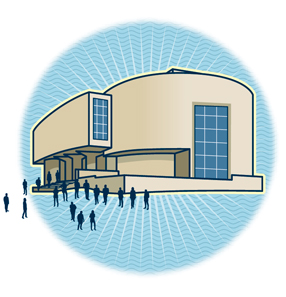
AU is home to an extraordinary treasure: the 9,000-plus-piece Corcoran Legacy Collection. It’s our privilege to care for it and share it with the more than 30,000 people who visit the American University Museum each year. “This is a great opportunity and a great responsibility,” says Jack Rasmussen, director and curator of the AU Museum. To ensure the full benefit of this historic acquisition, AU seeks funding to promote student engagement, enhance public programs, increase staff capacity, and update the museum’s exhibition and storage facilities—all of which will enable us to better steward this Washington treasure
PRESENTING OLD TREASURES IN A NEW LIGHT
The AU Museum has a rare opportunity to spark conversations in ways more traditional museums cannot.
“No one else can say what we say,” Rasmussen says of the museum, which hosts 25 exhibits a year. “It is a badge of pride at AU that we are among the most politically engaged campuses. This is a place to discuss issues.” Museums are conservative by nature—it is their job to conserve. Others are constrained by government funding. “We can take chances and court controversy,” Rasmussen continues.
In May 2018 AU received an unprecedented gift from the famed Corcoran Gallery of Art: 9,000-plus works, including masterpieces from Van Dyck, Lichtenstein, and Andy Warhol, currently valued at $31 million. The Corcoran Legacy Collection places AU among the top tier of university museums and raises our profile in a city of great cultural institutions. The gift from the Corcoran—one of the first private museums in the US, which closed in 2014—more than doubles the museum’s collection and complements our focus on works by women, people of color, and Washington artists. Where else can art lovers enjoy photographs by Ansel Adams, a video installation on linguistic boundaries, and paintings inspired by DC’s punk music scene?
AU now has the remarkable opportunity of presenting these pieces—many of which haven’t adorned a gallery wall in decades—in a new light. In fall 2019, 18 AU graduate students were the first to be given access to the collection, curating the 87-piece Moves Like Walter: New Curators Open the Corcoran Legacy Collection.
Other exciting exhibition opportunities abound at the AU Museum. Project Space, a new curatorial program launched in summer 2019, brings together students, academics, community partners, and nontraditional curators to create special interdisciplinary exhibitions. The inaugural show, Plans to Prosper You: Reflections of Black Resistance and Resilience in Montgomery County’s Potomac River Valley, was organized by graduate students in the anthropology, arts management, art history, and studio art programs. They partnered with local historical societies and African American communities to explore how blacks in Scotland, Tobytown, and Macedonia-Moses fought racial discrimination through faith, family, and fellowship. In addition to Project Space, which hosts three shows per year, professors and students use AU Museum exhibits to amplify classroom learning on subjects from psychology to language and culture.
Arts and culture are among the important ways AU engages the community, answering President Sylvia Burwell’s call for the university to be “a part of, not apart from” Washington. AU’s strategic plan, Changemakers for a Changing World, casts AU’s arts leadership in DC as a meaningful way to inspire, convene, and connect.
Philanthropic investment in the AU Museum is critical to presenting and preserving the collection, enhancing program offerings, and establishing the space as place of discourse, understanding, and artistic wonder.
For information on how to support big ideas in art and culture, contact Courtney Surls ,vice president of Development and Alumni Relations, at 202-885-5900 or vpdar@american.edu..
A Home for DC Art and Artists
A native Washingtonian, Carolyn Small Alper, CAS/BA ’68, envisioned a space in the city where students, scholars, and neighbors could immerse themselves in DC art history, engage with local artists, and exchange ideas. Thanks to her philanthropic leadership, the Alper Initiative for Washington Art—which opened its doors at the AU Museum in 2016—is now the epicenter of DC’s creative scene.
An artist herself, Alper studied painting under prominent Washington artists Morris Louis and Gene Davis. In 1971, she and three fellow students cofounded the Foundry Gallery. Located in the Shaw neighborhood, the space showcases contemporary works by the city’s most promising and accomplished artists.
“I hope [the initiative] will encourage Washington artists and become a place where artists can convene and talk. Art talk is the most creative stuff in the world,” Alper said in 2015. Five years later, the initiative has evolved beyond its benefactor’s initial vision. It’s carved out 2,000 square feet of gallery space and hosts five exhibitions a year, along with artist-led classes, gallery talks, and salon-style discussions.
Recent shows include Latitude: The Washington Women’s Arts Center, 1975–1987, which featured 90 pieces from the nonprofit’s founding mothers and exhibitors, and Prints and Artists: WD Printmaking Workshop, 1970–Present, which traced the evolution of the legendary Adams Morgan studio.
“The initiative has grown from highlighting contemporary artists to also delving into the history of Washington,” Rasmussen says. “We find out what is important and what needs to be reevaluated. We provide many looks at Washington—it’s a complicated place. The Alper Initiative is a place to meet and talk, to do research and evaluate.”
The acquisition of the Corcoran Legacy Collection marks an exciting turning point for the initiative, which is now an even richer and more robust repository for Washington art and history. By providing a home for these pieces, the AU Museum and the Alper Initiative honor the Corcoran’s legacy and continue its tradition of supporting and showcasing homegrown talent.